News

Akila to relinquish post: Karu to be UNP Leader?
Ranjith Madduma Bandara had intimated that they are willing to work together if Karu Jayasuriya is named as the Leader of the party.
Meanwhile, he had officially notified the Elections Commission yesterday (03) that they will contest the upcoming election under the 'Samagi Jana Balawegaya' led by Sajith Premadasa
Further, sources from the SJB said that they will announce the 'telephone', which is already registered under the party, as its symbol for the general election.
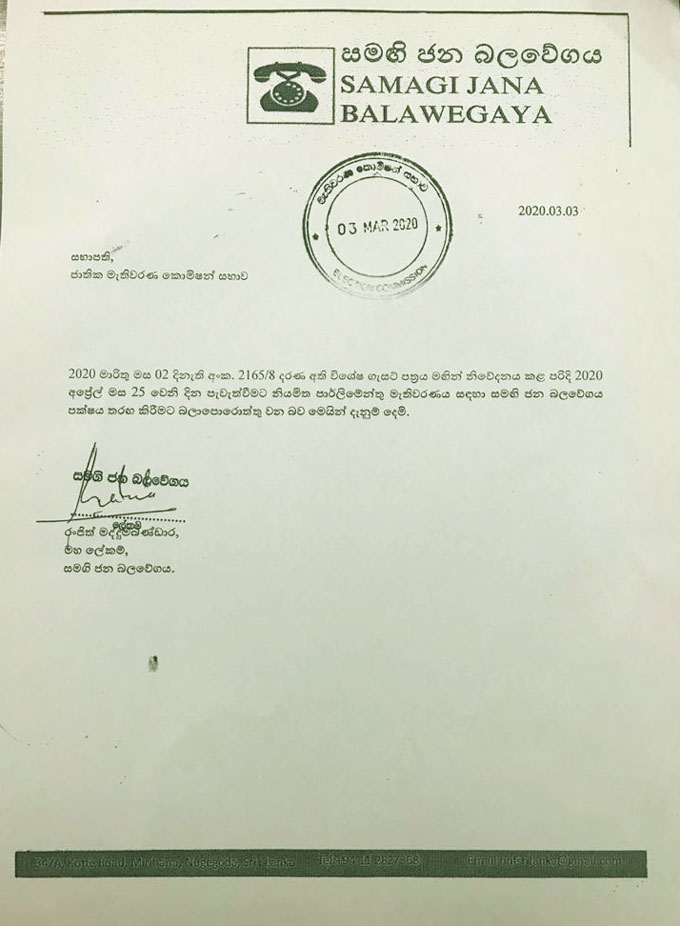
UNP Leader Ranil Wickremesinghe, who has decided to contest under the 'elephant' symbol for the upcoming general election, has directed UNP General Secretary Akila Viraj Kariyawasam to finalise the nomination list immediately.
Mediation by Mangala, Malik & Rajitha unsuccessful!
Former Ministers Mangala Samaraweera and Malik Samarawickrama, in an effort to resolve issues centered on the 'symbol' between the Ranil faction and the Sajith faction, had met both Ranil Wickremesinghe and Sajith Premadasa separately, yesterday. However, those discussions have been unsuccessful as they could not come to an agreement.
Meanwhile, Ranil Wickremesinghe has appointed former MP Rajitha Senaratne as a mediator to resolve these issues.
Accordingly, Senaratne met the Leader of the 'Samagi Jana Balawegaya' Sajith Premadasa yesterday (03) and a second round of discussions are scheduled to be held with senior members of the UNP today.
No possibility of joining whatsoever - Naveen
In this backdrop, former parliamentarian Naveen Dissanayake has said that the UNP cannot join the SJB under prevailing legal conditions.
However, former parliamentarian Lakshman Seneviratne observed that it would be immensely disadvantageous to the UNP if they decide to contest the election alone.
Akila vacates the post of General Secretary
Meanwhile, it is reported that UNP General Secretary Akila Viraj Kariyawasam is prepared to relinquish his post to consolidate the unity within the party.
This was revealed during a discussion yesterday (03), party sources said.
Sri Lanka Nidahas Podujana Sandanaya to contest from SLPP
Meanwhile, the Sri Lanka Nidahas Podujana Sandanaya which consist of a coalition of parties led by the Sri Lanka Freedom Party (SLFP) and the Sri Lanka Poudjana Peramuna (SLPP), has officially informed the Election Commission that they will contest the forthcoming general election under the SLPP. They will contest under the 'Pohottuwa' symbol.
All political parties must inform the Election Commission of their intention to contest within seven days of the declaration of an election.
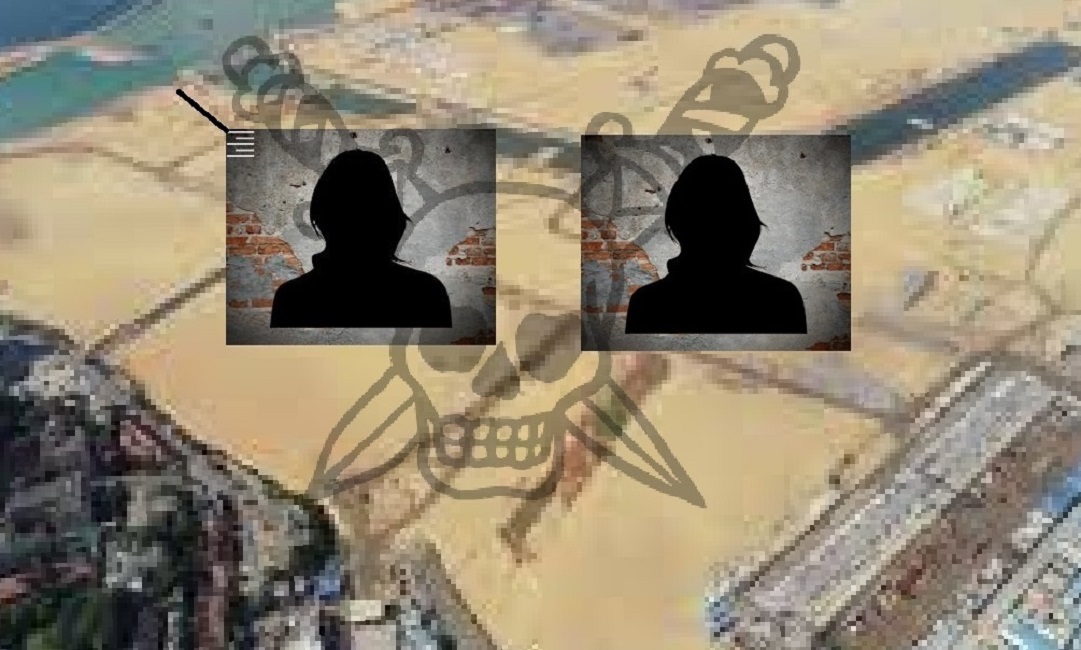
Port City Project: Allegations against officials for concealing shortcomings of Chinese company
According to sources from the Presidential Secretariat, Bimal Gonaduwa, who was appointed as the Project Director of the Colombo Port City Project by the Urban Development Authority (UDA) is being sidelined by the Chinese company in charge of construction while according preferential treatment to Deputy Project Director Piyusha Gunasekara.
It is also alleged that the Chinese company is taking a special interest in her because she is known to represent the interests of the Chinese company rather than the interests of the Sri Lankan government.
Nihal and Piyusha dancing to the Chinese company's tune!
After the incumbent Rajapaksa government came to power, Nihal Fernando, the then director of the Port City Project, was removed and Bimal Gonaduwa was appointed. It is said that his removal had to do with the fact that Nihal Fernando was revealed to be a pawn of the Chinese company.
At the time Nihal Fernando was sacked, the Mangaing Director of the company that is handling the construction of the Port City Project, Houliang Jiang, had made an effort to recruit him as a consultant to the Chinese company, but the government had refused.
According to Presidential Secretariat sources, Deputy Director of the Port City Project, Piyusha Gunasekara and Additional Secretary of the Ministry of Urban Development, Anjali Devaraja have also provided preferntial treatment to the Chinese company with the support of a high ranking official of the ministry.
Furthermore, Anjali Devaraja, who was a close associate of former minister Champika Ranawaka, had joined the ministry during the good governance regime and worked as a close associate of the minister. However, it is reported that she is now criticising the former minister and has distanced herself from the former minister and appears to be a close friend of the Rajapaksa government. An engineer by profession, she was a contemporary of Champika Ranawaka during their university days.
It has been reported to the Presidential Secretariat that the two female officials have been tactfully relieving the current Project Director from his responsibilities.
It is also reported to the theleader.lk that certain officials from the Urban Development Authority and the Ministry, have been concealing who have been supportive of the Chinese company, are concealing shortcomings of the company with regard to land reclamation and construction.
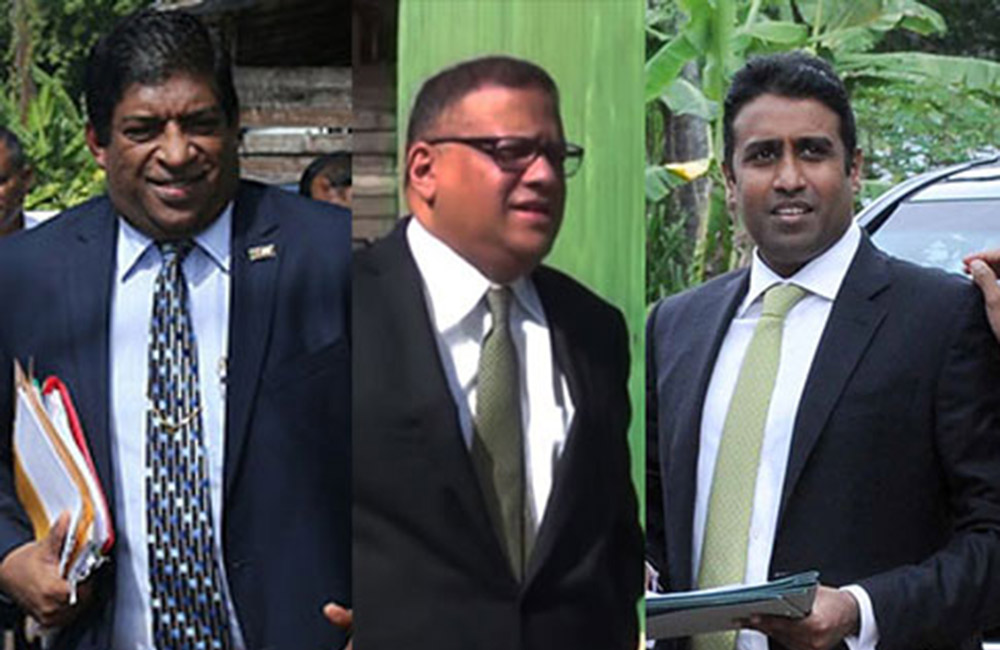
AG directs Acting IGP to arrest Ravi, Mahendran & Arjun
The Attorney General has directed the Acting IGP to obtain warrants to arrest former minister Ravi Karunanayake, former Governor of the Central Bank Arjun Mahendran, Arjun Aloysius, CEO of Perpetual Treasuries Kasun Palisena, former director of the Public Debt Department T. Sarathchandra and a few others today.
The Attorney General's Coordinating Secretary, State Counsel Nishara Jayaratne stated that the warrant has been issued for the arrest of the suspects on charges of conspiracy, criminal misappropriation, cheating and market manipulation with regard to the bond auction in March 2016.

PM begins election campaign by announcing Sri Lanka's withdrawal from the UN resolution
Prime Minister Mahinda Rajapaksa on Wednesday said that his government will withdraw from co-sponsoring a UN Human Rights Council resolution on accountability for war crimes.
His statement came days after the US imposed travel restrictions on Army chief Lt Gen Shavendra Silva and his immediate family members over alleged gross violations of human rights during the final phase of the island nation''s Civil War in 2009.
"Our government has decided to withdraw from the process of co sponsorship in relation to resolution 30-/1," the Prime Minister said in a statement.
The resolution 30/1 was co-sponsored in 2015 by the then Sri Lankan government.
Rajapaksa accused his predecessor of betraying the island's security forces by co-sponsoring the resolution.
"It is because of the historic betrayal that other countries are able to name members of our armed forces as violators of human rights," said Rajapaksa, who was president and commander-in-chief when Sri Lanka launched the offensive to crush the LTTE in 2009.
The 2015 resolution was based on the UNHRC report which had accused the Lankan troops of violating human rights, Rajapaksa’s statement said.
Sri Lanka's ruling and opposition parties have strongly opposed the US move to impose the travel ban on Lt. Gen. Silva, saying America's decision was based on independently unverified information.
Minister of Foreign Relations Minister Dinesh Gunawardena last week said that Lt. Gen. Silva was only conducting a war against a designated terrorist group which was the LTTE.
He was appointed as the Sri Lankan Army Commander last year and previously headed the Army's 58th Division in the final battle against the LTTE in 2009.
The UN rights body resolution had blamed Lt. Gen. Silva’s brigade of committing rights abuses during the final phase of the battle which ended in May 2009. Both government troops and the LTTE were accused of rights violations. The Sri Lanka Army has denied the alleged rights abuses.
Full text of statement:
“The United States of America has prohibited the Commander of the Sri Lanka Army Lt. Gen. Shavendra Silva or members of his family from entering that country. Even though we are now in the 21st Century, even members of his family who have not been accused of any wrongdoing, have been subjected to a collective punishment reminiscent of the practice in medieval Europe. The people should be the judge of how fair this is. Even though this collective punishment has been meted out on the grounds that the Army Commander had committed violations of human rights, no one knows what these allegations are.
Our government has already conveyed our displeasure in this regard to the government of the United States in the strongest possible terms. It is because of the historic betrayal committed by the yahapalana government formed by the United National Party, the Tamil National Alliance and the JVP in co-sponsoring UN Human Rights Council Resolution 30/1 in 2015 that other countries are able to name members of our armed forces as violators of human rights. The first operative paragraph of that Resolution had taken note ‘with appreciation’ the September 2015 Report of the Office of the High Commissioner on Human Rights which accused the Sri Lankan armed forces of human rights violations. This report was based on the previous 2011 unofficial report prepared by a three member committee appointed by the then UN Secretary General outside the established procedure of that organisation. In this manner, the UNP-TNA-JVP combine ended up accepting all the unfounded allegations made against our armed forces by various interested parties.
Even though the Army Commander of our country and his family have been subjected to a collective punishment reminiscent of medieval times, the yahapalana political parties have not condemned it. UNP Parliamentarian Lakshman Kiriella says that this travel ban imposed on the Army Commander and his family is the responsibility of the present government. The JVP says that the USA has imposed a travel ban on the Army Commander and his family at this particular moment due to a deal to ensure that the SLPP obtains a resounding victory at the forthcoming Parliamentary elections. For its part the Tamil National Alliance has welcomed the collective travel ban imposed on the Army Commander and his family. The people should take note of the fact that when the UNP government co-sponsored Resolution 30/1 in the UN Human Rights Council, the so called anti-imperialist JVP did not oppose it. From the discussion that has taken place with regard to the collective punishment imposed on the Army Commander and his family, it becomes clear that the political divide in this country is between the patriotic camp which puts the country first, on the one hand, and born traitors who are waiting for the first opportunity to betray the country, on the other hand."
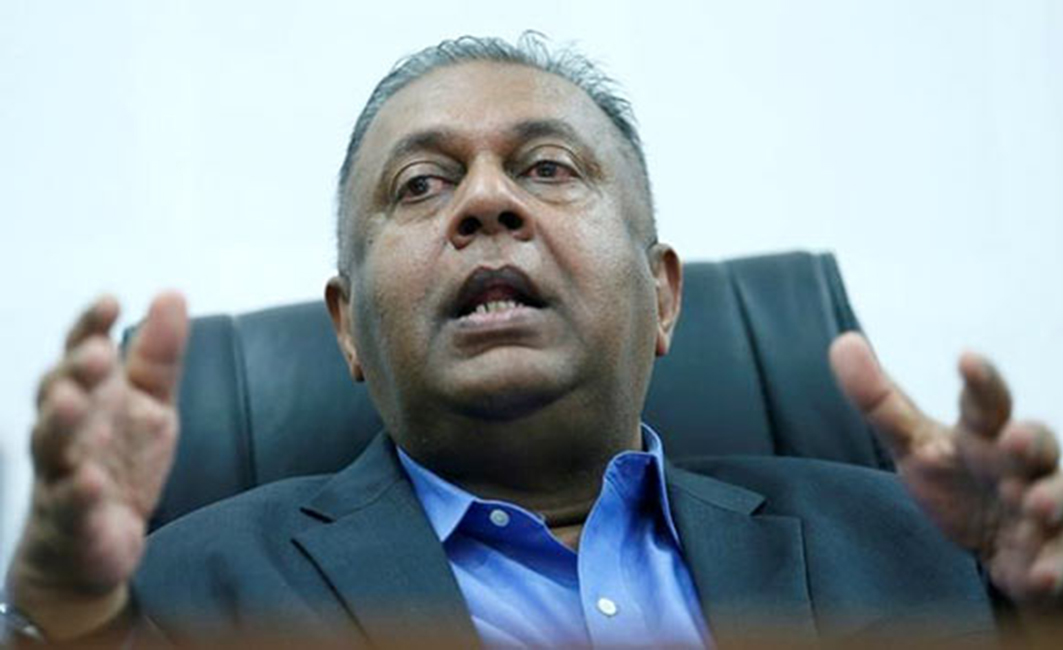
UNPers controlled by Rajapaksas working to divide the grand old party: Mangala
Samaraweera made these comments while speaking at the UNP Working Committee meeting held at the party headquarters 'Sirikotha' last night (01).
The parliamentarian observed that the formation of the new coalition was postponed due to minor issues for several months. At a time when the general election is scheduled to be announced in a few hours, the impediments to finalising the agreement have been the shameful actions of a few who are trying to divide the party and hand over an advantage to the incumbent government at their behest.
When MP Vajira Abeywardena had tried to interrupt, Mangala Samaraweera had said that "you are one of the conspirators."
Recalling the past where the SLFP had been in the opposition for 17 years from 1977 to 1994, Mangala Samaraweera had noted that the UNP would have to remain in the opposition for years if the party gets caught in such conspiracies. He had requested them to set aside other issues for the time being and focus on discussing matters related to the formation of the alliance immediately.
However, after the two sides had clashed over trivial matters, Samaraweera had walked out from the Working Committee meeting.
Sajith faction to contest from 'Samagi Jana Balawegaya'
However, the Working Committee meeting which was held yesterday ended without reaching consensus on a symbol and both parties had decided to contest separately.
The general secretary of the 'Samagi Jana Balawegaya' (SJB) Ranjith Madduma Bandara stated that the majority of UNP MPs have decided to contest the next general election under the SJB led by Sajith Premadasa.

Coronavirus hits manufacturing and services sectors
Sri Lanka’s manufacturing and service sector activities slowed down in January while new coronavirus (COVID-19) outbreak in China is leading to indefinite delays of supplies for manufacturing and slowdown in future expectations in tourism and transport sectors, according to the Central Bank’s SL Purchasing Managers’ Index (PMI).
Manufacturing activities recorded a PMI index value of 54, down from 54.3 index points in December, mainly due to the slower expansion in new orders, production and stock of purchases in the manufacturing of food and beverages sector with the decreasing demand after the festive season. The suppliers’ delivery time rose significantly in the month by 11.5 index points to 61.5 compared to December 2019.
“Although, lengthening of suppliers’ delivery time usually indicates higher demand for materials with the expanding manufacturing activities, the new coronavirus (COVID-19) outbreak in China since early January 2020 has mainly caused this delay.
“Further, many respondents in this sector highlighted that their import orders for materials from China have been delayed indefinitely due to the same reason,” the Central Bank said. Although manufactures, especially in the appeal sector, have cautioned that the new coronavirus outbreak would disrupt the global supply chain, overall expectations for manufacturing activities for the next three months remained slightly improved compared to December.
Meanwhile, services PMI recorded an index value of 57, which was 3.2 index points down from December 2019 following the seasonally high activity level prevailed in December 2019. However, Central Bank said the coronavirus outbreak overshadows future expectations in tourism and transport sectors. “Business activities in accommodation, food and beverage and telecommunication sub sectors expanded due to peak tourism season and tax reductions introduced by the government, respectively.
“Further, business activities in financial services, transportation, and wholesale and retail trade sub sectors also recorded a growth in January 2020,” the Central Bank said. In particular, employment increased in January following the continuous decline for nine consecutive months due to new recruitments at the beginning of the year.
The increase in employment also contributed towards the decline in backlogs of work in January 2020.
However, increase in expectations for activity in accommodation, food and beverage and transportation sub sectors sharply slowed down in January 2020 due to the impact of new coronavirus outbreak, which would lead to a decline in arrival of tourists and shipments from China.
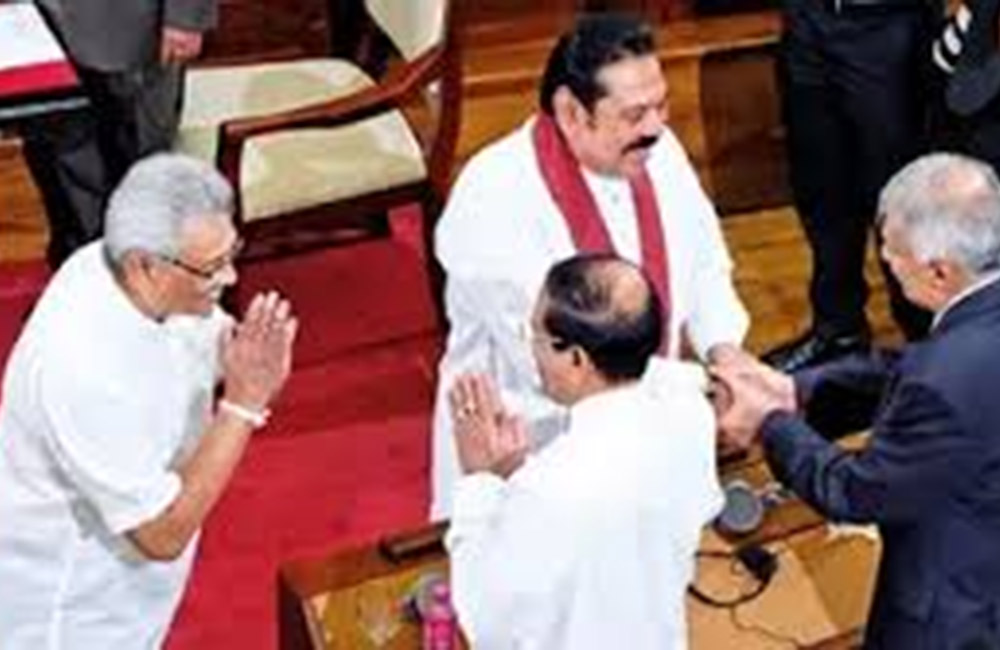
Will help President Gotabaya to form a strong Govt: Maithripala Sirisena
Former president and the Leader of the Sri Lanka Freedom Party (SLFP), Maithripala Sirisena says his party will extend its fullest support to strengthen the government of President Gotabhaya Rajapaksa at the next general election.
Accordingly, the SLFP will join hands with the Sri Lanka Freedom People's Alliance (Sri Lanka Nidahas Podujana Sandanaya) and contest the upcoming general elections under the 'pohottuwa' symbol. He said that the symbol of the party is irrelevant when fighting on behalf of the people in the country.
The former president made these comments while making the keynote speech at a workshop held for SLFP representatives in Polonnaruwa last Saturday (22).
Chairmen and members of Pradeshiya Sabhas as well as all other SLFP representatives in Polonnaruwa participated at this workshop.
SLFP Leader Maithripala Sirisena said that he is well aware of the challenges faced by the Gotabaya Rajapaksa government and observed that the payment of salaries to state sector workers have become a serious issue. He further said that the government also needs to settle a substantial amount in debts.
A strong Govt. can't be formed without the SLFP
Pointing out that it is funny to think that one could win the Polonnaruwa electorate without the support of the SLFP, the former president stressed on the need to unite and form a strong government at the general election.
While noting that the SLFP has launched a very systematic campaign, the former president said that he intends to strengthen the Gotabaya Rajapaksa government by working towards the victory of the most number of parliamentarians at the election.
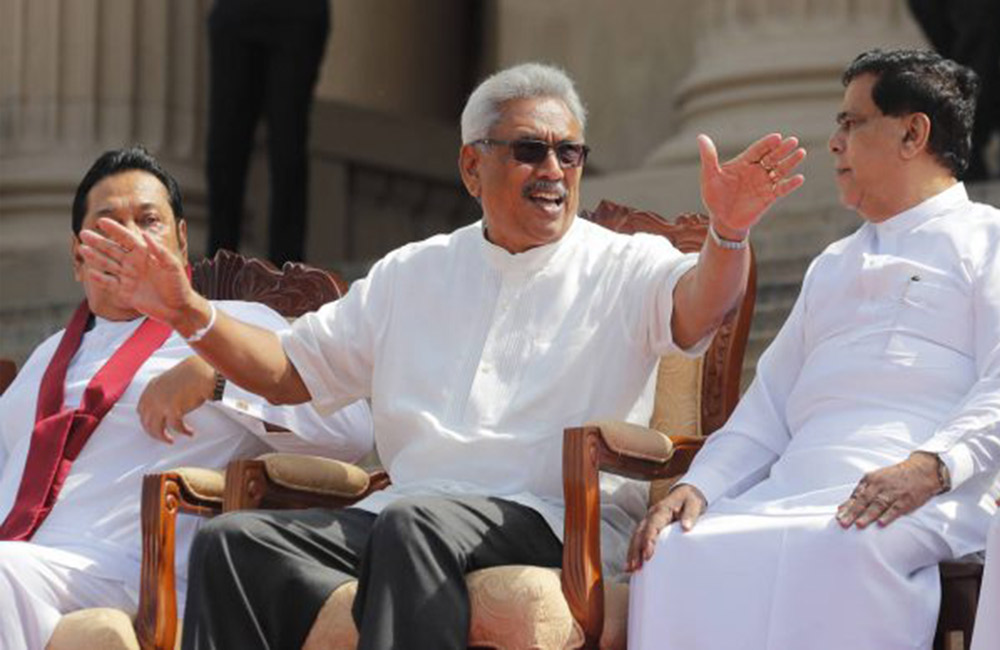
Cabinet seizes presidential powers and appoints ministry secretaries
Secretaries to two State Ministries have been appointed through the Cabinet, exceeding the powers vested in the Constitution to the President to appoint Secretaries to Ministries.
Cabinet Secretary S. Amarasekera announced the appointment of the Secretaries by issuing the Extraordinary Gazette notification No. 2162/20.
According to the gazette notification, B.M.S Balasuriya has been appointed as the Secretary to the Ministry of Internal Trade and Consumer Welfare and S.T. Kodikara has been appointed as the Secretary to the Ministry of Housing with effect from 14th of February.
The gazette notification further stated that these appointments were made in accordance with the provisions of Article 55 (2) of the Constitution.
However, Article 55 (2) of the constitution states that "the appointment, transfer, disciplinary control and dismissal of all Heads of Departments shall vest, in the Cabinet of Ministers." As such, there is no mention in the constitution of the power the Cabinet has with regard to the appointment of secretaries.
When a former senior Ministry Secretary was inquired, the official pointed out that according to the provisions of the constitution, only the president can appoint secretaries and not the Cabinet.
He also said that if the Cabinet of Ministers has made such appointments, it would be illegal and exceed the powers vested on the president by the constitution.
The incumbent government has set up State Ministries in addition to the Cabinet Ministries and the secretaries of those ministries have been appointed by President Gotabaya Rajapaksa up until this latest appointment of secretaries by the Cabinet.
Furthermore, the secretaries who were appointed by the president received their appointment letters which were signed by the Secretary to the President.
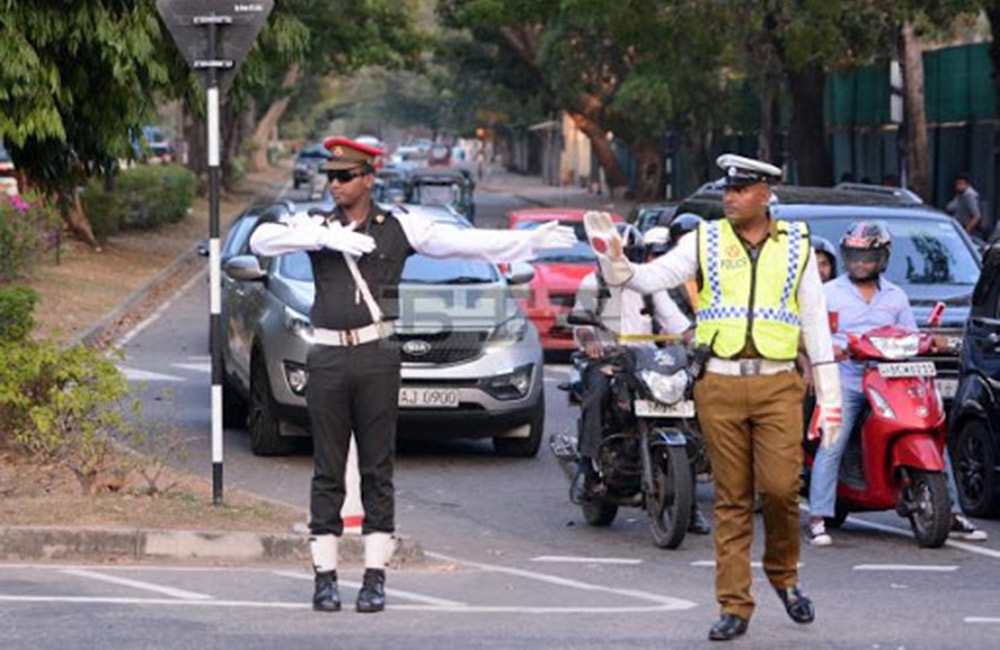
Govt. deploys troops to control traffic
The government has deployed troops to help police control worsening traffic congestion in the capital, the Army said Monday (Feb 24).
President Gotabaya Rajapaksa, a retired army officer, ordered the military to assist traffic officers at the main entry and exit points to Colombo, a city which nearly a million people enter or leave daily, a spokesman said.
The military police will also lend support "in any other area where their services are required", Army spokesman Chandana Wickremasinghe added.
Traffic slows to a snail's space in Colombo during the morning and evening rush hours making it one of the slowest road systems in South Asia.
Recent studies have shown average speeds drop below 7kmh in the morning and the evening.
The capital does not have a mass transit system, forcing many to use their own transport that chokes the narrow streets.
The former government began work on the country's first light rail transit system last year at an estimated cost of US$1.5 billion. The Japanese-funded project is expected to be operational within about five years.
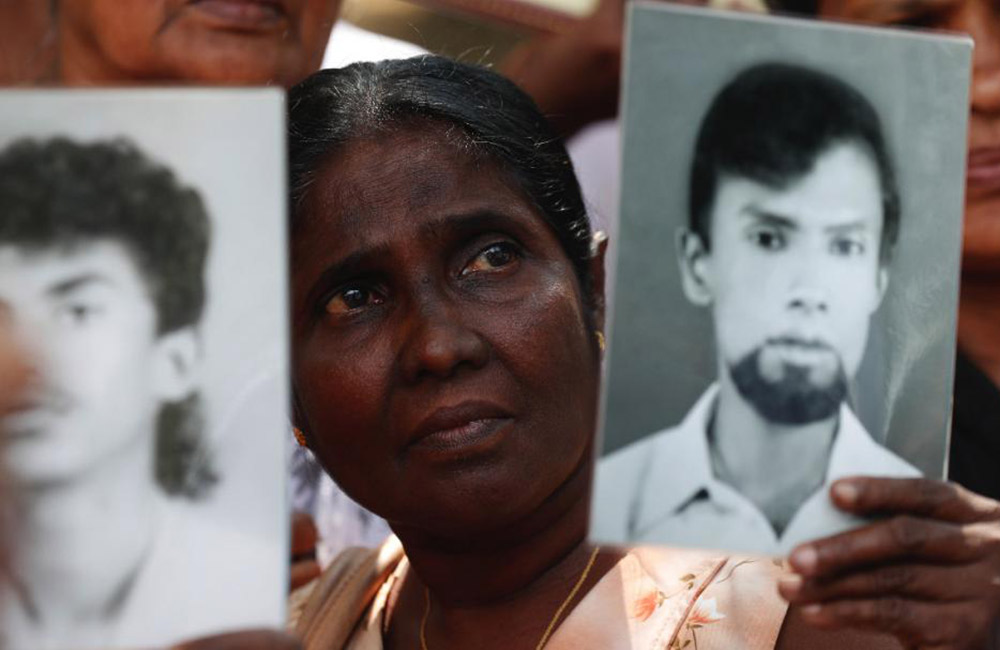
Families of ‘Disappeared’ threatened by state intelligence agencies
Sri Lankan security forces and intelligence agencies have intensified surveillance and threats against families of victims of enforced disappearance and activists supporting them since Gotabaya Rajapaksa became president in November 2019, Human Rights Watch (HRW) said today adding that the Sri Lankan government should fulfill its commitments to the United Nations Human Rights Council to strengthen efforts to locate the “disappeared” and bring those responsible to justice.
Activists working in six locations in the northern and eastern parts of the country on behalf of relatives of the forcibly disappeared told HRW that there has been a significant increase in government surveillance and intimidation. One activist said that prior to a recent victims’ meeting, “every one of the mothers got at least six telephone calls from different intelligence agencies asking, ‘Where is the meeting?’ ‘Who is organizing the meeting?’ ‘What is being said?’” Another activist said, “We can’t do any visible programs.… We’ve stopped everything.”
“The families of Sri Lanka’s ‘disappeared’ have spent years waiting for answers, but with the Rajapaksas back in power, security forces are threatening them to drop their demands for truth and accountability,” said Meenakshi Ganguly, South Asia director. “The government needs to stop the harassment immediately and abide by Sri Lanka’s pledges to the UN to uncover the fate of the ‘disappeared’ and provide justice to victims’ families.”
Thousands of people, primarily ethnic Tamils, are believed to have been forcibly disappeared in state custody between 2005 and 2015, when the current president was defense secretary and his brother, current Prime Minister Mahinda Rajapaksa, was president. President Rajapaksa has resisted demands for justice, including past Sri Lankan commitments to the UN Human Rights Council, and said at a recent meeting with the UN that the “missing persons are actually dead.”
During the bloody civil war, from 1983 to 2009, between the Sri Lankan government and the separatist Liberation Tigers of Tamil Eelam (LTTE), both sides committed numerous abuses, including enforced disappearances. UN reports found credible allegations of enforced disappearances by government forces of captured LTTE fighters and Tamil civilians during the final months of the war in 2009. Among the army units the UN implicated in the worst atrocities at the war’s end were those commanded by the current army chief, Gen. Shavendra Silva, and the defense secretary, Gen. Kamal Gunaratne. On February 14, 2020, the United States State Department designated Silva and his immediate family members ineligible for entry into the US “due to credible information of his involvement, through command responsibility, in gross violations of human rights, namely extrajudicial killings.”
The new Rajapaksa administration has halted legal proceedings initiated by the previous government against navy officers accused of the enforced disappearance and alleged killing of 11 young men in Colombo and its suburbs in 2008 and 2009. In November 2019, following the presidential election, a government investigator looking into this and other cases of alleged serious rights violations implicating government officials fled the country following threats. Other criminal investigators have since been put under travel restrictions.
A member of the advocacy group Mothers of the Disappeared whose son was forcibly disappeared in 2009 told Human Rights Watch that since the presidential election she has been repeatedly visited by members of the police Criminal Investigation Department (CID).
“They have come and asked who is going to meetings,” she said. “And who is going to Geneva [to attend the UN Human Rights Council]. These are children who were taken by white vans from our houses or who surrendered [to the army]. These are the children we are talking about. I want to know what happened to my son – whether he is dead or alive, and if he is not alive, what happened to him and who did it; whether he was beaten, whether they broke a limb.”
A person who works closely with the families of the disappeared said that under the relatively open environment of the previous government, many relatives of the disappeared had chosen to speak out about their cases. “Now they [the security forces] know who talked about their crimes, so the victims have fears about their safety,” he said.
The previous Rajapaksa administration had repeatedly denied government involvement in serious human rights violations, including enforced disappearances. However, under international pressure, Mahinda Rajapaksa in 2010 established the Lessons Learnt and Reconciliation Commission, which acknowledged an “alarming” number of allegations of disappearances in state custody, and said the government was “duty bound” to take “immediate” steps to bring those responsible to justice.
In 2015, the Sri Lankan government under President Maithripala Sirisena joined a consensus resolution of the UN Human Rights Council. A core commitment was to set up four transitional justice mechanisms to promote “reconciliation, accountability and human rights,” including an accountability mechanism involving international judges, prosecutors, and investigators; a truth and reconciliation mechanism; an office on missing persons; and an office for reparations.
Sri Lanka has made limited progress in meeting these commitments, but an Office on Missing Persons (OMP) and an Office for Reparations have been established. During the election campaign and since taking office, the Rajapaksa government has said it does not intend to abide by the internationally recognized process to address alleged grave international crimes by both sides. The government has also cast doubt on the future of the Office on Missing Persons.
Given Sri Lanka’s long history of enforced disappearance, it is vitally important not to allow the government to simply dismiss these cases. UN member states at the Human Rights Council in late February should call upon Sri Lanka to comply with its international legal obligations, protect victims and witnesses, and keep its UN pledges in a time-bound manner.
Should the government fail to do so, the council should take the initiative and adopt accountability measures leading toward international investigation and prosecutions.
“Family members of Sri Lanka’s many ‘disappeared’ have a right to know what happened to their loved ones,” Ganguly said. “The UN Human Rights Council is the one flicker of hope many families have that the fate of those disappeared will one day be known, and that justice will be done.”
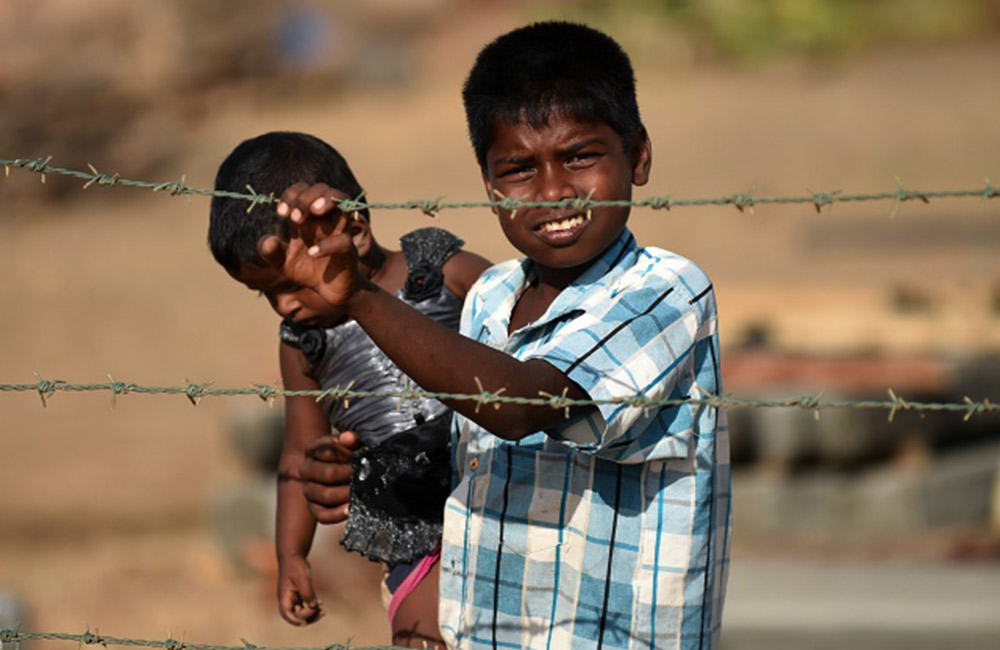
Government must spell out an alternate roadmap for reconciliation
The National Peace Council says that the travel restrictions imposed on Army chief Lt Gen Shavendra Silva is a continuation of a regime of international sanctions against Sri Lanka on the grounds of its unwillingness to deal with unresolved issues of the final phases of the war.
Following the announcement of the government's decision to withdraw from co-sponsorship of UNHRC Resolution 30/1, the National Peace Council (NPC) called on the government to demonstrate its continuing commitment to national reconciliation by spelling out its alternative roadmap which will address the concerns of all Sri Lankans.
In a statement, they point out that in September last year, the United Nations (UN) suspended Sri Lankan Army deployments in its peacekeeping operations after then President Maithripala Sirisena appointed General Silva as Army Commander accusing him of command responsibility for serious human rights violations.
"The decision of the US is argued to be on the basis of information found in UN and other reports available as far back as 2014. In October 2015, the Sri Lanka government agreed to address these concerns by co-sponsoring UNHRC resolution 30/1 which set out a roadmap to reconciliation.
On the other hand, the withdrawal of the US from the UNHRC in 2018 was seen as debilitating those commitments. It needs to be noted that the sanctions are being implemented only after there are indications of backsliding from governmental commitments made in the 2015-19 period. With Prime Minister Mahinda Rajapaksa’s announcement of the government decision to withdraw from Sri Lanka’s co-sponsorship of the UNHRC resolution, the National Peace Council (NPC) is concerned about further sanctions that could potentially be injurious to the country," the NPC said.
The National Peace Council said that the appropriate path for Sri Lanka to take at the present time would be that of restorative justice where the state would acknowledge the human rights violations and crimes of the past that occurred on all sides and focus its priority attention to restore the lives of those who survived to the maximum level possible.
Sri Lanka's Permanent Representative to the UN, Kshenuka Senewiratne, recently said "Sri Lanka is committed to find innovative and pragmatic solutions driven by the domestic context to protect the country’s national interest guided by the provisions of the Constitution, and the will of the citizens expressed through democratic means." Therefore, the Sri Lankan government should now demonstrate its continuing committement to national reconciliation through an alternative roadmap which will address the concerns of all citizens.
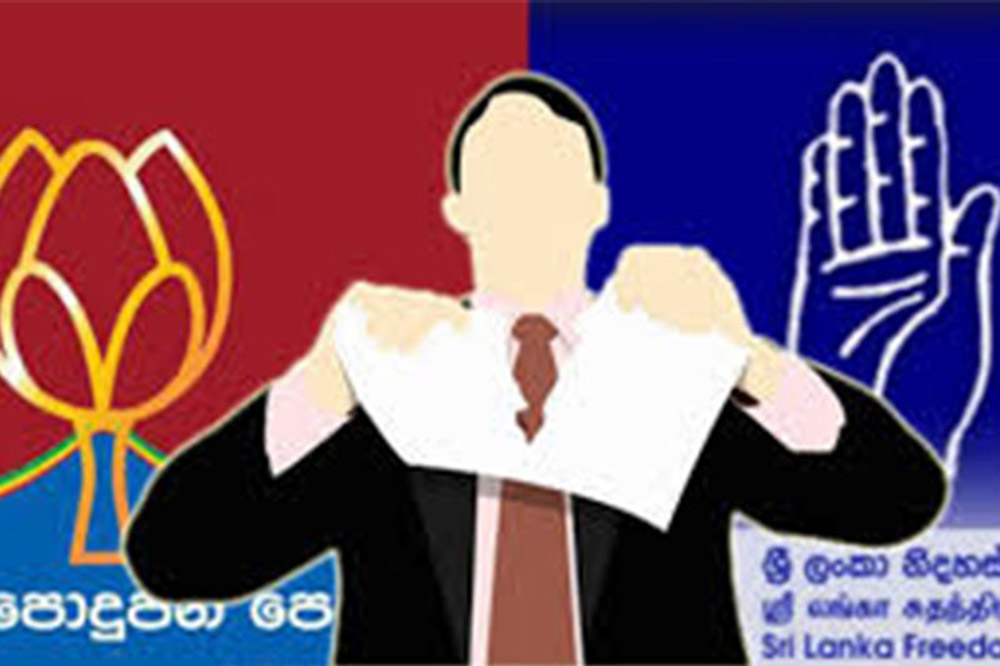
No alliance: SLPP to contest under 'Pohottuwa'
According to the 'Anidda' newspaper, a party leader of the proposed alliance between the Sri Lanka Podujana Peramuna (SLPP) and the Sri Lanka Freedom Party (SLFP) has said that the formation of the alliance between the two parties would not take place before the upcoming general election and that the SLPP would have to contest under the 'Pohottuwa' symbol.
The newspaper report further states:
“If the new alliance is to registered, it should be done before the dissolution of parliament on March 10,” the party leader pointed out adding that they would only have two weeks to finish the entire process.
He said that the leaders of the Sri Lanka Podujana Peramuna were clearly not interested in forming a new alliance and that they would prefer contest the polls under SLPP with 'Pohottuwa' as its symbol.
He also said that this was the stance taken by Basil Rajapaksa, the National Organiser of the SLPP during the discussions he held upon his arrival to Sri Lanka.
Dullas Alahapperuma and Raja Collure, who were assigned with the task of registering the new alliance, have been quite busy with other activities, he added.
Page 376 of 628